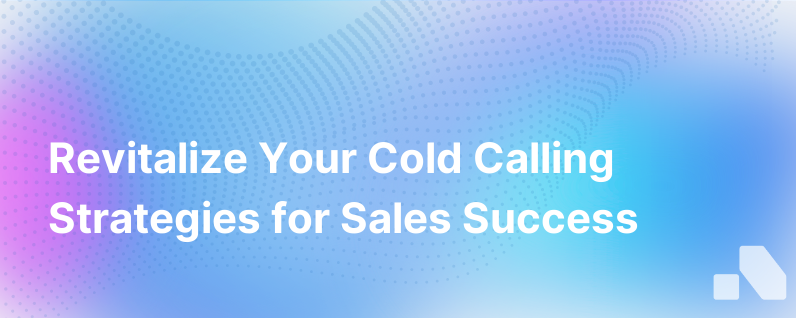
In today's digital landscape, the efficacy of cold calling as a sales tactic is a hotly debated topic. Amidst the rise of social selling, email outreach, and other online strategies, dialing a stranger and pitching your product might seem antiquated or invasive. However, cold calling remains a cornerstone of many successful sales operations, proving its resilience and potential when done strategically and thoughtfully.
This detailed guide will unpack the art and science of cold calling, offering insights and techniques to turn what many see as a dreaded task into a productive lead generation tool.
Understanding Cold Calling
Cold calling is the act of contacting a prospect with whom you have no prior relationship, usually over the phone. The "cold" aspect refers to the lack of a warm introduction or previous interaction, making it a challenging process as you aim to bring warmth and familiarity to a potentially icy reception.
Yet, despite the challenges, cold calling offers unique opportunities to:
- Quickly convey value propositions
- Immediately address concerns or objections
- Build a personal connection that electronic communication can't always match
Mastering the Art of the Cold Call
Crafting a successful cold call requires certain foundational elements that hinge on both strategy and human psychology.
Preparation is Key: Before you dial, arm yourself with knowledge. Understand who you're calling, their role, pain points, and how your offering aligns with their needs. Anticipate objections and prepare responses. This preparation showcases your professionalism and respect for the prospect's time.
Perfecting Your Pitch: Your opening seconds on a call are critical. You need a succinct, compelling hook that piques interest and promotes engagement. Practice your pitch—ensure it's clear, concise, and communicates benefits, not just features.
Active Listening: Successful cold calling is as much about listening as it is about speaking. It provides real-time feedback on your pitch and informs how to guide the conversation. Listen for verbal cues that signal interest or hesitation and adapt your approach accordingly.
Timing and Persistence: Timing can be everything in a cold call. Research optimal calling times for your industry and remember, follow-up is crucial. Most sales are made after the initial contact, so persistence and tactfully timed calls can make or break your success.
Psychology of Persuasion: Incorporate principles from the psychology of persuasion—reciprocity, commitment, social proof, authority, liking, and scarcity—into your calls. For instance, referencing satisfied customers provides social proof, while a limited-time offer creates a sense of urgency and scarcity.
Innovative Techniques in Cold Calling
The following strategies enhance the traditional cold-calling approach, increasing the chances of converting prospects into leads:
Use of Technology: Sales intelligence tools provide detailed insights into prospects' business activities and pain points. Integration with CRM systems streamlines call scheduling and follow-ups. Leverage these technologies to personalize each call and ensure no opportunity falls through the cracks.
Multichannel Approach: Cold calling doesn't have to work in isolation. Incorporate email, social selling, and other mediums into a cohesive strategy. Augmenting cold calls with other touchpoints reinforces your message and keeps you top of mind.
Soft Skills Development: Cultivating empathy, patience, and adaptability can greatly improve call outcomes. Every interaction should feel personalized and respectful, and every objection handled with understanding and tact.
Data-Driven Insights: Use call analytics to refine your approach. Analyze successful calls to replicate what works and pivot away from ineffective tactics. This data-driven feedback loop is essential for continuous improvement.
Real-World Application
Imagine a scenario where a seasoned sales rep at a burgeoning SaaS company relies on cold calling to build their pipeline. They perform meticulous research on LinkedIn, gather firmographic and technographic insights using sophisticated sales intelligence software, and schedule calls based on when prospects are most likely to be available.
During calls, the rep connects business challenges to specific software features and shares success stories from similar clients (social proof). By actively listening, they grasp the prospect's hesitance about implementation time, assuring them with a concrete timeline demonstration of the company’s authority on the subject.
Overcoming Common Challenges
Facing rejection is an inescapable aspect of cold calling. Overcoming this emotional hurdle is pivotal. Normalizing 'no' as a step closer to 'yes' encourages resilience.
In addition, as gatekeeping becomes more sophisticated, finding ways to reach decision-makers directly is another ongoing challenge. This requires creative problem-solving, such as leveraging mutual connections for introductions or engaging prospects on platforms where they actively share insights, like LinkedIn.
The Future of Cold Calling
While the future is digital, human interaction retains its power. Sales calls have evolved into more precise and value-driven interactions, thanks to robust data and technological advancements. Cold calling remains a craft, and when wielded by a well-prepared and strategic salesperson, it is a potent weapon in the modern sales arsenal.
Conclusion
Cold calling is not extinct but has evolved. Equipped with modern tools and techniques, the practice continues to serve as a dynamic part of the B2B sales process. In an era of automated outreach and burgeoning digital communication, the human element of a voice on the line can be both refreshing and persuasive.
As part of a comprehensive sales strategy that values preparation, persistence, and personalization, cold calling can be highly effective. It's all about adapting this time-honored sales method to the expectations and technological realities of today's market. When integrated judiciously, cold calls can significantly boost your outreach efforts, leaving a lasting impression and contributing to a robust pipeline.